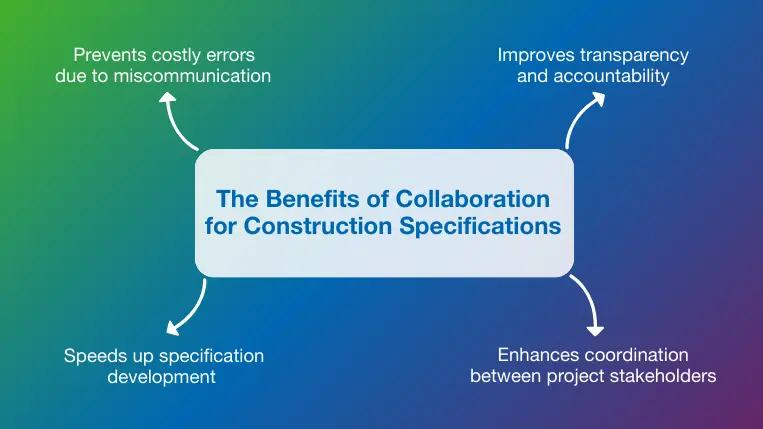10 mins read
The Importance of Collaboration for Successful Construction Specifications

Collaboration is at the heart of any successful business operation, regardless of the industry or sector. Team members must effectively coordinate and communicate with each other for activities to run smoothly and according to plan. This principle is especially important in the construction industry, as many different trades and teams must work together on several processes to successfully bring the project to life.
Effectively managing and developing construction specifications is one of those activities. One that relies explicitly on collaboration more than any other. However, ensuring cooperation and communication during the spec management process is difficult, especially as projects become more complex.
Fortunately, professional specifications software like RIB SpecLink significantly facilitates communication by giving team members access to the information they need in real-time, reducing the likelihood of mistakes due to miscommunication.
This blog post explores the importance of collaboration for construction specifications and how innovative software is the most efficient solution for success. Let’s dive in!
The Benefits of Collaboration for Construction Specifications

Miscommunication issues when developing specs can lead to a huge waste of time and money, which can set back a project’s success and damage the relationship between contractors and clients. The key to success is a well-implemented system where all trades can collaborate in real-time and keep a history of changes. Below, we explain why!
Prevents costly errors due to miscommunication
Multiple people editing and rewriting specs without collaborating can lead to discrepancies that result in costly errors and RFIs. With a proper collaboration system, these discrepancies can be avoided or caught early, ensuring accuracy and efficiency when managing specs. This level of precision also translates into financial success for the project, as no extra money needs to be spent fixing errors during construction.
Improves transparency and accountability
Without proper collaboration, spec changes and revisions become more challenging to track. The latest changes might get lost in an infinite email thread, resulting in people working with outdated versions that can affect the project’s quality. This is all easily avoidable with the proper collaboration techniques in place. Powerful specification management tools like RIB SpecLink allow users to track changes in real-time and make comments to ensure everyone understands what was changed and why, increasing transparency and accountability during the spec writing process.
Enhances coordination between project stakeholders
For construction specifications to be successful, all disciplines, including MEP, architecture, structural, and more, must be aligned to prevent conflicts and costly rework later. Using a collaborative specification system, project teams can review specs together, using standard and clear language, and resolve any discrepancies before finalization. This collaborative approach also allows for productive discussions between disciplines, which can result in increased project quality and profitability.
Speeds up specification development
As mentioned above, generating specs is a team effort where multiple experts contribute to achieving the expected quality requirements for the project. With traditional specification methods like emails or Word documents, the construction specifier must spend excessive time coordinating the changes manually, taking away valuable resources that could be dedicated to other high-value tasks. Software like RIB SpecLink automates spec editing, making it up to 70% faster than traditional methods. Specs can be easily accessed by different users, and comments can be made in real-time, eliminating the need to go through emails and last-minute changes manually.
Tips for Effective Collaboration When Managing Construction Specs with RIB SpecLink Cloud
As you’ve learned, collaboration has many benefits for effective specification management. The topic was discussed in detail in one episode of our webinar series RIB SpecTalk, where experts, including specifiers, architects, quantity surveyors, and other construction professionals, offer invaluable tips to streamline specs following best practices and using software like SpecLink.
1. Use a cloud-based specifications software
The first and most invaluable tip provided by experts at RIB is to leave email chains and outdated Word documents in the past and invest in professional spec management software. Leading tools in the market, like RIB SpecLink Cloud, offer a centralized, online location to manage specs successfully. With continuous access to the latest version and the ability to comment and collaborate in real-time, firms can reduce the time it takes to edit specs by 70% while also reducing the risk of RFIs by 30%.
2. Collaborate in real-time
Expanding on the point above, experts emphasize the importance of real-time collaboration for successful spec development. Traditional email exchanges create confusion, as team members might be working with outdated versions that can result in costly rework during construction. RIB SpecLink works on the cloud, meaning the different trades and teams can access specs simultaneously and leave comments for specific team members. This ensures the input gets to the right person quickly and without confusion.
3. Assign role-based access
While collaborating is essential, controlling who can access and edit specs is also important, as someone might accidentally alter a piece of content and affect the project. RIB SpecLink allows users to set role-based permissions to limit the actions each user can take on the content. For example, they can give “read-only” access to owners and contractors or “section-based” access for specific trades to limit visibility only to the necessary part of the specs and avoid accidental issues or unauthorized modifications.
4. Boost Collaboration with Office Masters & Smart Linking
Another best practice for faster and more efficient collaboration is using an Office Master. An Office Master serves as a template to standardize specifications across multiple projects instead of creating a new set of specs for each project. SpecLink Cloud’s Office Master feature helps cut the time it takes to write specs by half, with the option to standardize common sections, product selections, and firm-specific language to facilitate team communication and coordination.
In addition, the smart linking feature in our specifications software allows users to activate or deactivate content based on specific parameters. Thus, teams can ensure the necessary requirements are correctly applied across sections to prevent contradictions and potential RFIs.
5. Keep a version history to track changes
Transparency and accountability are key to successful collaboration. RIB experts suggest users benefit from SpecLink’s version history feature, which allows them to see who made changes, when, and why. Solving discrepancies or potential misunderstandings makes it easier to ensure aligned specs.
6. Use automated reports
Another way to guarantee efficient collaboration is to ensure that pending comments or revisions are not overlooked or forgotten. SpecLink’s automated comment reports ensure all feedback is visible and addressed before finalizing specs. For example, a firm might generate a materials report to ensure contractors approve any material substitutions before construction begins.
7. Focus on external collaboration too
During spec development, collaboration should go beyond internal accessibility. RIB SpecLink Cloud ensures external stakeholders like contractors, owners, and manufacturers can also access and comment on specs without requiring a paid license. This facilitates collaboration, taking the administrative burden of sharing specs with people outside the organization.
Final Thoughts
Collaboration in construction specifications does not have to be a burden with the right technology. RIB SpecLink Cloud offers a single source of truth to manage all specification content in real time, eliminating version control issues that can lead to costly rework. The powerful functionalities discussed throughout this post allow our users to edit their specs up to 70% faster than traditional methods, all with collaboration at the forefront.
If you want to improve your spec management process and join a community of construction professionals who offer continuous support in all topics surrounding specs, subscribe to the upcoming SpecTalk. New episodes are released every two weeks!
If you are curious about our state-of-the-art specifications software and want to experience the benefits featured here firsthand, get your free demo for RIB SpecLink Cloud today!

Most Recent
10 mins read
29 mins read
27 mins read
24 mins read
Blog Categories

Ebook











